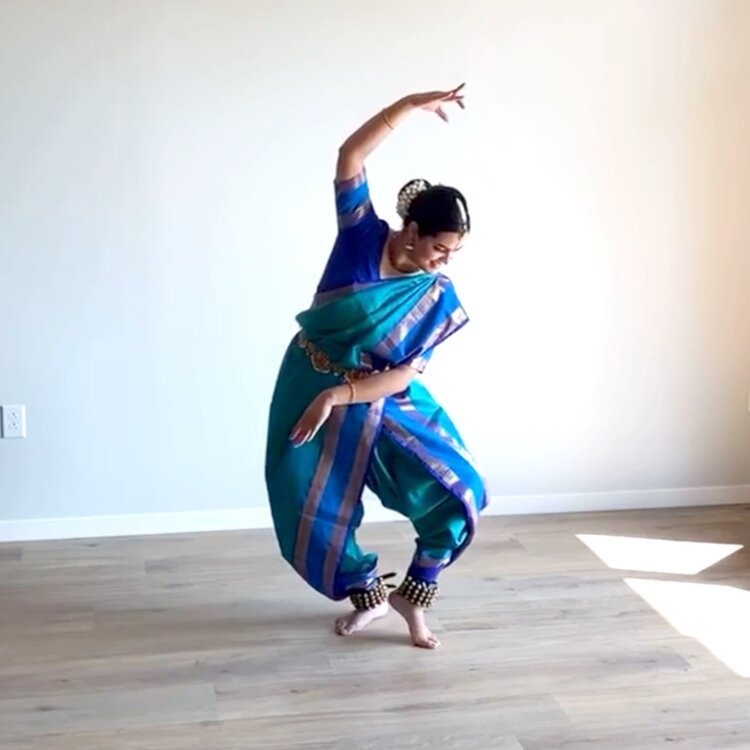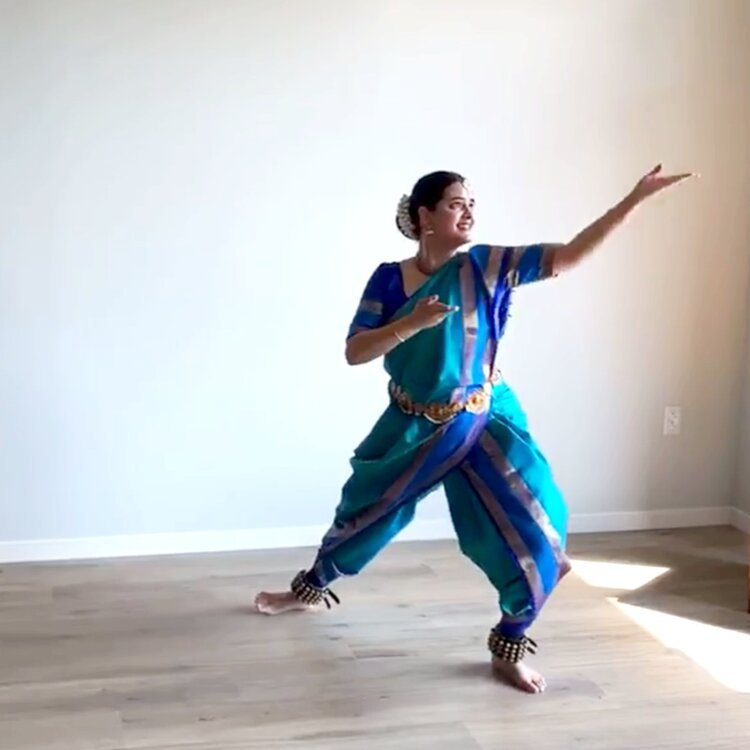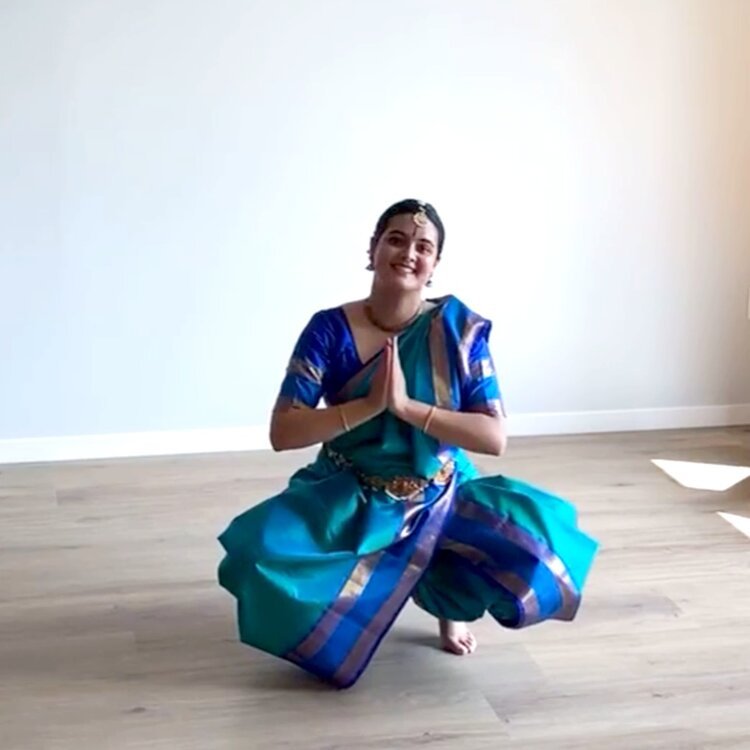“it was always so exciting for me to go to dance class and depict that same story that I might've heard from my grandmother:” Practicing Bharatanatyam Indian Classical Dance
“When you're a little kid, your parents and your grandparents and everybody tells you stories. In India, a lot of the stories that are told to little kids are mythological and historical stories. And so it was always so exciting for me to go to dance class and depict that same story that I might've heard from my grandmother, you know, five years ago.”
Interview by Caitlin Coad
Sharadha has practiced and performed Bharatanatyam, a type of Indian classical dance, for 20 years, since she was 5 years old. In that time she’s lived in Chicago, Hong Kong, Bangalore, New York, Bombay, Pune, and now Philadelphia. We spoke in May 2020 about her Bharatanatyam practice.
Can you describe the type of Indian classical dance that you do?
There are many, many different types of Indian classical dance. Historically India has been invaded by lots of different clans and rulers. And so you will find some forms of the classical dance that are influenced by say the Mughals, for example.
But the dance form that I learned is called Bharatanatyam and it is a very ancient dance form, indigenous to the Indian sub-continent. It is based on Hindu scriptures, and in fact, there is a whole scripture written on this dance form called the Natya Shastra. And so that is historically where they say all the steps and hand gestures, concepts and deeper meanings came from. Over the years it's become also a form of dance that is able to depict and express, almost as dance ballets, a lot of mythological stories in Hindu and other general Indian mythology.
When you're a little kid, your parents and your grandparents and everybody tells you stories. In India, a lot of the stories that are told to little kids are mythological and historical stories. And so it was always so exciting for me to go to dance class and depict that same story that I might've heard from my grandmother, you know, five years ago.
Do you have a memory of the first time you saw Bharatanatyam dance or learned about it?
I don’t specifically have any memory of the first time I saw the dance form. I’ve been told that when I was a small kid, between the ages of 2 and 5, I used to jig around a lot. And that's how my parents thought of putting me in dance classes. I started when I was 5. It's a running joke that if you are a South Indian girl, you will probably be taught Bharatanatyam!
The way the learning of Bharatanatyam works is based on an ancient Indian tradition. It's called the Guru-shishya parampara. Guru means teacher, shishya means student and parampara means tradition. So back in the olden days, to learn things ranging from math and science, to dance and singing, little children would be sent to the house of their guru, and they would actually live with them for many years, growing up and being schooled by their Guru. After a certain age they'd be brought back to their parents' home. Of course I didn't go and live with my gurus. But it was in their house that I’d go dance and come back.
The way you learn it is that there's a certain set of steps you can do with your feet, and also a certain set of hand gestures and movements. Initially when the teacher teaches you, she teaches you all of those basics. Once you're done with the basics you progress to having a dance piece with a certain song or a certain rhythm to it. And the teacher will choreograph a various combination of steps for that piece.
The big deal when you’re a kid in Bharatanatyam is there is something you do, which is called an Arangetram. An Arangetram is the first time that you perform solo on stage. It's a three-hour performance! It is quite rigorous and it takes a year and a half to prepare for that. I did my Arangetram when I was 15. Many people see it as an end in itself, but in all honesty, I would say it's just the beginning. After that, you have so many more opportunities to perform alone and to hone your skills even further as you grow older and older.
And were you born in India and learning there or were you somewhere else?
No, actually I was born in Chicago, and then we moved to Hong Kong and that is where I started learning. It was an interesting experience there because Hong Kong is very much of an expat community, so people keep moving in and out. And so I think in the time span of like, three years, I had four teachers. I started learning when I was 5, so between 5 and 8 I had to change teachers 4 times.
Then we moved back to India, specifically to Bangalore. It was then at the age of 10 that we found my current guru. Her name is Padma Murali, she has been living in Bangalore for a long, long time.
It's funny, we actually just stumbled upon her classes because she used to live in the same apartment complex that we did. We saw all these little girls going into this house, and they were all dressed in traditional attire. I think it has been the best thing that we stumbled upon. Now I'm 25, so for the past 15 years, I've been with this same Guru.
Do you think there was anything different learning the dance in Hong Kong versus India?
Absolutely. It was completely different. A lot of people who teach dance believe it to be a deeply spiritual thing. In the Hindu religion, it is considered to be a sort of offering to the lord that you worship. That whole concept was something that I was introduced to only after moving to India. At the beginning of every class, my teacher in India would make us say a small prayer and she would keep this idol of Nataraja, and light a lamp and put flowers in front of it. These tiny things were the differences that I noticed initially.
As I got older, we would often travel to the temple towns of India and we would do this circuit of dancing in temples. There's a festival called Shivaratri, it is the one night when people stay awake the whole night worshiping the Lord Shiva. The dance festivals we attended happened in the South of India, in the temple towns of Tamil Nadu. It’s quite a prestigious thing to do, because you can go only by invitation. And so you’d get invited to 4 or 5 [temples], and it was great fun. We'd all go as a troupe, and we'd be jumping from temple to temple. The temple towns may be separated by an hour or two hours drive, so you'd get completely decked up, and then go in that decked up and slightly sweaty state to all the different temples. So I think that was definitely the hugest thing that I could never get outside of India. Because it's just simply not the same.
And the other big thing that I've noticed is the audience. So they always say that you're not dancing for your audience, you're dancing for yourself —and I totally agree with this. But the truth is that in reality sometimes when you have an audience that can appreciate the dance form in its technical aspects, then you yourself as a dancer, feel like, ‘Okay, I should push myself a little extra to make sure not muddle up these technicalities.’ The appreciation you receive from a Bharatanatyam critic is obviously different than even the appreciation you receive from your own parents, for example.
How do you judge what an excellent performance is?
There’s a variety of factors, and each viewer will have their own factors. What I look for in a dancer is if they hold their body well in the various postures, and sit very stiffly so things that are not supposed to move are not moving. And also what I look for is a certain amount of fluidity. It sounds funny because on one hand I’m saying that I appreciate a stiff and firmly held posture, but on the other hand I’m saying fluidity. By fluidity I mean how one step flows into the next step; a balance that is struck between doing steps very firmly but then being fluid when you are depicting emotions.
I judge how well emotions are being depicted. For example, there’s one emotion which I find many people find difficult to express which is the love of a mother for her child. If they’re able to depict the story so well that you feel the emotion that the story is telling, that is really the pinnacle of great dancing.




You said that for most girls in Tamil Nadu, it's sort of expected that they learn this. Does everyone continue like you have?
No. There are people who start dancing and then exam time happens, or it's time to apply to college, and that becomes their main focus - no judgement there, to each their own. For me personally, this is more than just a hobby. In India we have in the 10th grade what they call board exams. I remember during my 10th grade exams, there was a really close friend of mine who was learning to play the guitar and he was really good. But his parents said, ‘No, you have to stop now. It's time to focus on just studying.’ But for me, I had categorically told my parents, ‘If you do not let me dance, I am not going to study either. So you can take your pick.’ The thrill that I get from this form of dance doesn't come from anything else.
So you've been with your current guru from the age of 10 to 25. And during that time, you've moved around a lot, so how do you maintain that?
It’s interesting, as we are in Coronavirus time right now, it's actually been great for my dance because I've been able to restart classes with my teacher. Ever since I moved to the U.S. I started doing Skype classes with her. I position the camera such that she can see my entire body from head to toe. All the parts of the body are important for her to be able to correct me. She needs to see how I'm stamping my feet, whether my legs are in the correct diamond; she needs to see the expressions on my face, and my arms, as well. The only thing that's been a challenge has been the time difference, but now because I'm home all the time, I'm actually able to have an hour of dance class in the mornings.
Since you moved to the U.S. you haven’t been able to perform yearly in the temples, but have you found any substitute for that?
Not really, no. To be honest over here I haven’t yet been able to tap into the full Indian cultural scene. I’m a bit of a purist when it comes to my dance. When I’m dancing Bharatanatyam I want to do it in the traditional way. And here there seems to be a lot of demand for fusion (which I do very much enjoy as an art form in itself). I think there are pockets, like New Jersey has a lot of Indians doing it the traditional way, and California, so I think I’ve just not yet found my niche in the U.S.
It’s a huge conscious effort to keep it up here. I haven’t performed on stage at all since I came to the U.S., even though there are avenues, it’s just to seek out those avenues takes a lot more effort than it did in India obviously. Over here it would be very very easy for me to just completely lose touch and never dance again.
Why do you keep it up?
It’s a way of life for me. In the time periods when I haven’t been dancing, it feels like there’s a void. If I even manage to get three or four days of practice in, I feel good about that week. So I think it’s as important and essential to me as breathing, eating or even, you know, staying intellectually stimulated.
What do you hope to be doing with it in the next couple years?
I would love it if I could get back in shape and start performing myself, [and also] start formally training in Carnatic music. Ideally I would love to start teaching. There’s a tradition, when you teach Bharatanatyam we have this wooden slab and a wooden stick. You beat the stick on the slab to give rhythm to students. There’s a ceremony [where] the teacher gives it to you, kind of saying, ‘I’m passing on my art form to you.’ My teacher has already given me my slab and stick, and so now it’s time to start teaching! It’s interesting when you try to start teaching, you realize that there’s a lot more to learn.
…
Postscript
A few months after we spoke, Sharadha performed for the first time since moving to the U.S.
She performed a recital live for an online audience at the Naatya Sabha Mysuru facebook page at 10:30am Eastern Standard Time/7:30pm Indian Standard Time. Sharadha shared this about the performance:
“I think the most wonderful thing that I had almost forgotten, was that feeling during a dance performance when I completely lose myself in the dance, and then there is no audience or me, there is just the dance itself. It’s what people refer to in various contexts as ’the magic moment.’
This performance came along as an opportunity presented to me by my Guru. She very kindly passed on the contact information of the organization and person handling this, and I took it from there - He was also very kind and encouraging.
It was fun practicing for it, because I found myself dancing much more regularly than I have done in a long, long time. This all actually just popped up a few weeks ago, and so it’s been a pretty intense time in terms of the practice and making sure I get it all right.
This was my first online performance ever, and it definitely felt different than being on stage. I was almost more nervous because I would be so close up to the camera and even the smallest fumble would be easy to catch. The music was recorded, but we held it close enough to the recording device so it sounded real :) Dancing to live music is, of course, a whole other level of joy in and of itself!
It was also my first performance without my mother to help me get dressed up, but I must say, my husband did a marvelous job at filling in for her and helped me every step of the way!”
This conversation has been condensed and edited.
Show Love
Sharadha’s online dance portfolio
Learn more about Bharatanatyam and the Pallandur school Sharadha trained under
View demonstrations of how to wear Bharatanatyam costumes made of silk sarees, and traditional jewelry.



